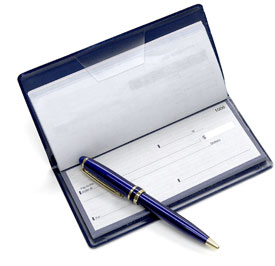| Introduction
 Whether you have a history of non-sufficient funds issues or you just want to know how to best manage your first checking account, this module will give you the tools and information necessary to handle your account responsibly. You will learn all of the components of wise checking account management: Whether you have a history of non-sufficient funds issues or you just want to know how to best manage your first checking account, this module will give you the tools and information necessary to handle your account responsibly. You will learn all of the components of wise checking account management:
- Checking Account Fundamentals
- ChexSystems
- Use ATM and Debit Cards Wisely
- Endorsing a Check
- Your Checking Account Statement
Chapter 1: Checking Account Fundamentals
By learning the fundamentals of checking accounts, you can maintain a positive, long-term relationship with your financial institution.
The most basic and important aspect of checking account management is to ensure there is enough money in your account to cover your transactions.
If you write a check for more than is in your account, the check will be rejected when it comes in for payment. It will be sent back to the person who deposited it and your financial institution will charge you a non-sufficient funds fee (NSF) for "bouncing" it. The merchant you wrote it to will also charge you a returned check fee. You may even be subject to court proceedings that can result in fines and being required to take special money management classes.
Tools for wise checking account management
- Balance your checkbook regularly.
- Review your checking account statement every month.
- Get the most current information about your account by using the telephone, Internet, or ATM.
- Know the fees associated with your accounts.
- Know how your financial institution processes checks. Some process the largest checks first. If your first check bounces, all checks processed that day will bounce as well, each with its own charge.
- Use overdraft protection.
- Use direct deposit. Avoid mail delays or lost and stolen checks by having your paycheck or federal payments deposited electronically.
"Always and Nevers"
Always
- Always discontinue automatic payments before closing your account.
- Always remember that you, not your financial institution, are responsible for monitoring account activity.
- Always notify your financial institution if you change your name or address.
Never
- Never close your checking account by letting it go to a zero balance. If you don't actually close it, fees may continue even with no funds in the account.
- Never give your personal identification number (PIN) to someone else.
- Never use other people's checks, or let others use yours.
- Never write a post-dated check. It can be cashed before the intended date, and if you don't have enough money in your account to cover the check, you will overdraw your account.
Overdraft Protection
Checking linked to savings
Funds are transferred from your savings account into your checking account to cover the amount of the overdraft. There may be a transfer fee for the service, but since you are using your own money, you aren't charged interest.
Line of credit
If you overdraw your checking account, money is transferred from your line of credit into your checking account. The money may be transferred in amounts larger than your overdraft. For example, if you overdraw your checking account by $19.00, the institution might transfer $100.00 into the account. You will pay interest on the transferred amount.
Credit card charge
As with the line of credit, you may be able to arrange with your financial institution to charge your credit card to cover your overdrafts. Again, this may result in more money transferred into your account than would be necessary to cover the overdraft. |

 Whether you have a history of non-sufficient funds issues or you just want to know how to best manage your first checking account, this module will give you the tools and information necessary to handle your account responsibly. You will learn all of the components of wise checking account management:
Whether you have a history of non-sufficient funds issues or you just want to know how to best manage your first checking account, this module will give you the tools and information necessary to handle your account responsibly. You will learn all of the components of wise checking account management: